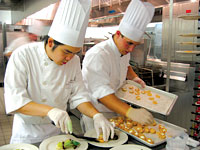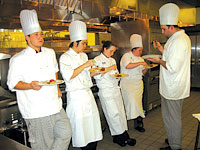Most home cooks have a go-to dish that they’ve prepared so many times—often to the vocal dismay of whomever they’re feeding—that the recipe, long ago lifted from an instant-rice box or an in-flight magazine, is seared into their brains like grime on a frying pan. Even the most ambitious amateurs often resort to putting meatloaf—or tuna casserole or taco salad—on the table again and again.

When home cooks get stuck in a kitchen rut, it’s usually because they’ve found a meal that’s cheap, easy and disproportionately delicious. But when the pros do it, it’s called practice—and, in the case of A-B Tech’s hot-food team, it may mean the difference between a gold and silver finish at the upcoming American Culinary Federation’s student-team championship.
The five members of A-B Tech’s team have been rehearsing their contest menu since last September, devoting upwards of eight hours a week to their pan-seared striped bass, mixed greens, chicken threaded with beef tongue and vanilla cream aboard a spice cookie.
“I’m not sick of them yet, but I’ve seen them a lot,” team member Michelle Bailey recently confessed when confronted with yet another bucket of potatoes awaiting transformation into the cute parsley-specked oblongs that would buddy up to the chicken on the entrée plate.
The team has gone through untold pounds of peas, beets, sweet potatoes and tomatoes in the process of perfecting their Appalachian Trail-themed menu, which has already won top honors in the state and regional divisions of the prestigious annual competition. A-B Tech will face three final contenders at the national event in Orlando this weekend.
While instructor Bronwen McCormick, who serves as a team coach, doesn’t know what the other teams plan to prepare, she’s confident the A-B Tech students will be well served by their knack—noted appreciatively by past judges—of communicating quietly and effectively. In a setting where every contributor is armed with a selection of very sharp knives, that’s a huge plus.
“They work well together as a team,” McCormick says. “There’s no fussing, no pot throwing. It’s been very pleasant.”

But since competitors aren’t graded on their ability to channel Rachel Ray, cultivating a sunny disposition isn’t enough to take the crown. Their food must be flawless, which is one reason the team held a series of practice dinners this summer, treating the public to a meal prepared under competition conditions. (The other reason was to raise money for the program: All that produce gets awfully pricey.)
According to contest rules, teams have three hours and 20 minutes to prepare their four-course meal, followed by 40 minutes to serve it. The only prep work that can be done in advance is peeling: Butchering, chopping and nearly every other get-ready task must be done on the clock, which never stops ticking.
“I like the fact I don’t face the clock,” team member Chambli Stuber admitted to her teammates as they counted down to start time for a recent practice dinner. At precisely 3:30 p.m., their work began. Here’s a blow-by-blow account of what followed.
3:35 p.m.: Each of the team members is responsible for one of the courses, but prep tasks are divvied up among all four cooks (the fifth member, Jason Huang, functions as executive chef, and is expressly forbidden from touching any food prior to plating). Stuber’s on salad duty, but handles the appetizer-bound striped bass at prep time. “It’s really simple,” she says of her job filleting the fish just-so and extracting any pesky bones. When the team first wrote its menu, it plugged mountain trout into the appetizer slot. “But it has a lot of pin bones and takes a lot of time,” Stuber explains. “Smaller fish are easier to work with.”
With one month left until show time, the menu is still being tweaked on an almost daily basis. While all teams were required to make the same classic entrée, a Supreme de Volaille a’Ecarlate dreamt up by legendary chef Auguste Escoffier, the remaining courses were left up to them.
“The students own this menu,” McCormick says.
3:38 p.m.: Huang is rolling vinegar-dipped cheesecloth into tight rolls, which he’ll later use to mop plates clean before they’re delivered to the table. Although he’s essentially the team manager, he’s stuck with lackey jobs tonight: He can sweep, empty trashcans and return ingredients to the cooler. Huang is a veteran of competition cooking: He was a member of last year’s team, which lost at nationals by one tenth of a point. “The bar is definitely raised,” he says.
3:50 p.m.: Almost everyone is frantically spraying, wiping and drying their cutting boards. Teams are scored on sanitation and waste reduction, which means leftovers are packed into carefully labeled storage containers (unused potato parts, for example, go into a bin marked “for staff meal”) and all traces of them are meticulously erased. “As much as they can, they need to keep unsightly things out of sight,” explains Charles deVries, a baking and pastry-arts instructor who coaches the team alongside McCormick.
4:07 p.m.: Twelve seedless oranges at Stuber’s station are now 72 tiny segments, which she must group into trios of matching sizes for the salad plates. As she carefully picks through the fruit, wearing plastic gloves sticky with citrus juice, Bailey starts the custard for her dessert.
4:15 p.m.: Daniel Gorman and McCormick are fretting over tomatoes. Gorman is charged with slicing off their tops, so they can be stuffed and plated with the entrée, but neither student nor teacher feels they’ve found an adequate way to ensure each tomato is the same height. A previous judge had suggested placing the tomatoes in a cylinder before cutting. “I just want them to be level,” sighs McCormick.
4:17 p.m.: “Whoa, I got a major issue here,” says Bailey, who’s just lost the plunger on her pastry gun, resulting in a sudden storm of custard. The problem is quickly solved, with Gorman providing a replacement gun and Huang rushing to the station with a mop. “Better to get that out of the way today, huh?” Bailey comments.
4:35 p.m.: Bailey’s moved on to potato prep, a tedious and hand-cramping task to which she and Matt Gruber will devote much of the next hour. The bulky taters need to be shaved into tournes, a seven-sided football shape. “It looks really nice on the plate, and it’s a nice skill to show judges you can do,” Bailey says.
4:39 p.m.: The dried-fruit compote that bespoke the season in which the team’s dessert was created (read: the dead of winter) now seems stale and out-of-sync with the sprightly flavors woven through the first three courses. So it’s out with the compote and in with the rhubarb, a stalky vegetable that’s new to Stuber. “These need to be peeled?” Stuber asks deVries after he nudges her. “I’m not used to rhubarb. Actually, I’ve never worked with rhubarb.”
5:07 p.m.: The team members swap places, a complicated maneuver they claim aids the workflow. Gorman, the mascot of the group at just 19 years old, leaves behind his detailed task schedule.
“Daniel, do you want your procedure sheet?” Bailey asks upon taking over his station.
“I didn’t even know it was there,” he says.
“I’m so proud,” says McCormick, whose approval Gorman frequently solicits. “I’m having a proud moment right now.”
5:22 p.m.: The judges at the competition keep pocketfuls of spoons to dip into dishes as they’re being prepared. McCormick and deVries do the same, although they expect the students to keep tasting their work too. “The judges want to see tasting all the way through,” says deVries. Bailey offers Stuber a hastily scooped spoonful of her custard: “Tastes really good,” she assures her. “Maybe some salt.”
5:30 p.m.: Crunch time. A nervous energy overtakes the kitchen, where Gorman is dancing a little jig while waiting for Huang to cut him a sheet of plastic wrap. The comfortable quiet that ruled at the start of the session has been replaced by incessant calls for timer checks. “Daniel, you’ve got one minute and 13 seconds. Matt, one-forty-three,” Huang barks. The guests are starting to arrive.
6:09 p.m.: Gorman is transferring his green-pea sauce (which isn’t quite as green as the last time he prepared it, when a chef said he was put off by the bright color) to a thermos to stay warm. Right now, it’s plenty hot, as Gorman discovers when he accidentally pours a dollop on his thumb. All of the cooks bear the familiar scars of kitchen work: bandaged fingers and rosy-red burn marks.
6:38 p.m.: The team is still experimenting with new techniques, including baking their custards in a flexible mold that is now refusing to free the vanilla cream. While Stuber struggles with the stubborn tray, Huang sets up a heat lamp, creating an instant expo station.
6:50 p.m.: The first course is served. Although the pea-sauced bass is the featured player, guests are wowed by the scoop of sweet-corn salsa and accompanying crunchy black-eyed pea terrine. “I could eat that for snacks,” McCormick says.
7:08 p.m.: Guests are equally adoring of the salad, with its creamy sweet-potato napoleon and punchy pickled beets. McCormick isn’t so sure: “I’m not buying the microgreens this time,” she tells a fellow instructor, poking the space between the micros and mixed greens with her fork. “At the very least, it needs to be continuous here.”
7:27 p.m.: “This is absolutely perfect,” exclaims one diner as he cuts into the chicken. The cooks must wait until dinner is concluded to taste their food, so Gorman asks deVries for an update on the entrée: “Do you like that?” he asks. DeVries nods in a way that suggests he can’t quite find the words to convey his pleasure. “I can’t wait to try it,” Stuber says.
7:40 p.m.: Dessert doesn’t work. Although it’s capped with a stunning crown of spun caramel, neither the flavor nor the presentation matches the team’s expectations. “That’s why it’s called practice,” Bailey observes.
But the chicken is an unbeatable salve for any disappointment. “Man, that chicken,” Gruber moans. “Chicken, chicken, chicken, I gotta taste this chicken,” says Huang, bee-lining for a plate.
“We had some incredible chicken tonight,” deVries says in his thank-you speech to the gathered guests, all of whom have filled their comment sheets with compliments. “So far, this team has received gold medals all the way through, and I expect that to continue.”



Before you comment
The comments section is here to provide a platform for civil dialogue on the issues we face together as a local community. Xpress is committed to offering this platform for all voices, but when the tone of the discussion gets nasty or strays off topic, we believe many people choose not to participate. Xpress editors are determined to moderate comments to ensure a constructive interchange is maintained. All comments judged not to be in keeping with the spirit of civil discourse will be removed and repeat violators will be banned. See here for our terms of service. Thank you for being part of this effort to promote respectful discussion.